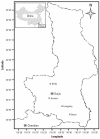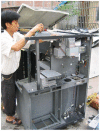Elevated blood lead levels of children in Guiyu, an electronic waste recycling town in China
- PMID: 17637931
- PMCID: PMC1913570
- DOI: 10.1289/ehp.9697
Elevated blood lead levels of children in Guiyu, an electronic waste recycling town in China
Abstract
Background: Electronic waste (e-waste) recycling has remained primitive in Guiyu, China, and thus may contribute to the elevation of blood lead levels (BLLs) in children living in the local environment.
Objectives: We compared the BLLs in children living in the e-waste recycling town of Guiyu with those living in the neighboring town of Chendian.
Methods: We observed the processing of e-waste recycling in Guiyu and studied BLLs in a cluster sample of 226 children < 6 years of age who lived in Guiyu and Chendian. BLLs were determined with atomic absorption spectrophotometry. Hemoglobin (Hgb) and physical indexes (height and weight, head and chest circumferences) were also measured.
Results: BLLs in 165 children of Guiyu ranged from 4.40 to 32.67 microg/dL with a mean of 15.3 microg/dL, whereas BLLs in 61 children of Chendian were from 4.09 to 23.10 microg/dL with a mean of 9.94 microg/dL. Statistical analyses showed that children living in Guiyu had significantly higher BLLs compared with those living in Chendian (p < 0.01). Of children in Guiyu, 81.8% (135 of 165) had BLLs > 10 microg/dL, compared with 37.7% of children (23 of 61) in Chendian (p < 0.01). In addition, we observed a significant increasing trend in BLLs with increasing age in Guiyu (p < 0.01). It appeared that there was correlation between the BLLs in children and numbers of e-waste workshops. However, no significant difference in Hgb level or physical indexes was found between the two towns.
Conclusions: The primitive e-waste recycling activities may contribute to the elevated BLLs in children living in Guiyu.
Figures






Similar articles
-
Blood lead and cadmium levels and relevant factors among children from an e-waste recycling town in China.Environ Res. 2008 Sep;108(1):15-20. doi: 10.1016/j.envres.2008.04.002. Epub 2008 Jun 2. Environ Res. 2008. PMID: 18514186
-
Association between lead exposure from electronic waste recycling and child temperament alterations.Neurotoxicology. 2011 Aug;32(4):458-64. doi: 10.1016/j.neuro.2011.03.012. Epub 2011 Apr 6. Neurotoxicology. 2011. PMID: 21477618
-
Blood lead levels and associated factors among children in Guiyu of China: a population-based study.PLoS One. 2014 Aug 19;9(8):e105470. doi: 10.1371/journal.pone.0105470. eCollection 2014. PLoS One. 2014. PMID: 25136795 Free PMC article.
-
Blood lead levels in children, China.Environ Res. 2006 Jul;101(3):412-8. doi: 10.1016/j.envres.2005.11.007. Epub 2006 Jan 25. Environ Res. 2006. PMID: 16442092 Review.
-
Blood lead levels of children and its trend in China.Sci Total Environ. 2009 Jun 15;407(13):3986-93. doi: 10.1016/j.scitotenv.2009.03.018. Epub 2009 Apr 22. Sci Total Environ. 2009. PMID: 19395068 Review.
Cited by
-
Developmental Lead Exposure in Rats Causes Sex-Dependent Changes in Neurobiological and Anxiety-Like Behaviors that Are Improved by Taurine Co-treatment.Adv Exp Med Biol. 2022;1370:461-479. doi: 10.1007/978-3-030-93337-1_43. Adv Exp Med Biol. 2022. PMID: 35882819
-
Ecological Risk and Human Health Implications of Heavy Metals Contamination of Surface Soil in E-Waste Recycling Sites in Douala, Cameroun.J Health Pollut. 2019 Mar 14;9(21):190310. doi: 10.5696/2156-9614-9.21.190310. eCollection 2019 Mar. J Health Pollut. 2019. PMID: 30931170 Free PMC article.
-
Human Body Burden of Heavy Metals and Health Consequences of Pb Exposure in Guiyu, an E-Waste Recycling Town in China.Int J Environ Res Public Health. 2021 Nov 26;18(23):12428. doi: 10.3390/ijerph182312428. Int J Environ Res Public Health. 2021. PMID: 34886154 Free PMC article. Review.
-
Connecting gastrointestinal cancer risk to cadmium and lead exposure in the Chaoshan population of Southeast China.Environ Sci Pollut Res Int. 2018 Jun;25(18):17611-17619. doi: 10.1007/s11356-018-1914-5. Epub 2018 Apr 17. Environ Sci Pollut Res Int. 2018. PMID: 29667054
-
Environmental lead pollution threatens the children living in the Pearl River Delta region, China.Environ Sci Pollut Res Int. 2012 Sep;19(8):3268-75. doi: 10.1007/s11356-012-0837-9. Epub 2012 Feb 29. Environ Sci Pollut Res Int. 2012. PMID: 22374191
References
-
- Allsopp M, Santillo D, Johnston P. Environmental and Human Health Concerns in the Processing of Electrical and Electronic Waste. Greenpeace Research Laboratories Technical Note. 2006. [[accessed 30 August 2006]]. Available: http://www.greenpeace.to/publications/Ewastetreatment-May2006-FINAL.pdf.
-
- Baghurst PA, McMichael AJ, Wigg NR, Vimpani GV, Robertson EF, Roberts RJ, et al. Environmental exposure to lead and children’s intelligence at the age of seven years: the Port Pirie Cohort Study. N Engl J Med. 1992;327:1279–1284. - PubMed
-
- Brigden K, Labunska I, Santillo D, Allsopp M. Recycling of electronic wastes in China and India: workplace and environmental contamination. 2005. [[accessed 2 August 2006]]. Available: http://www.greenpeace.org/india/press/reports/recycling-of-electronic-wa....
-
- CDC (Centers for Disease Control) Preventing Lead Poisoning in Young Children. Atlanta, GA: Centers for Disease Control; 1991. [[accessed 2 Sptember 2006]]. Available: http://wonder.cdc.gov/wonder/prevguid/p0000029/p0000029.asp#head00100000....
Publication types
MeSH terms
Substances
LinkOut - more resources
Full Text Sources

